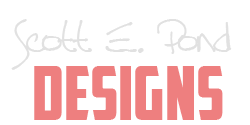Originally published in LinkedIn by Scott E. Pond on January 10, 2015
As designers, one of our main goals—aside from creating the best designs we can—is to acquire clients worthy of our works and worthy of us both as designers and as individuals. Without clients and the perks they bring (money, fame, raving fans, all-access-pass to the Playbunny mansion, and additional exposure), we are just operating in a vacuum, creating projects for a fun hobby and remaining mostly unrecognized and under-appreciated.
Throughout the years, I’ve had a lot of fantastic clients… and quite a few who turned out to be not so fantastic.
With each experience, a picture began to solidify in my mind, that of the Ideal Design Client.
Those of you who have clients know what I am talking about. There are some clients who are a complete joy to work with, some who you wish had never contacted you in the first place, and everyone else in between.
One of the key characteristics that makes a great client is the commonality of vision.
By vision, first I’m talking about compatible artistic vision. There are multiple aspects to this. One is the style of the artwork and creative output. A client who prefers manga style art may not be satisfied by an artist who specializes in golden age comic style art, whereas a client who loves realism in their art would potentially love an artist who specializes in photorealistic compositions. No content creator can be everything to every client. Some of us specialize in a narrow band of styles and mediums, while others have a more expansive set of skills. While you may love to experiment in different genres and styles, the time to do that is not when you are lining up a potential client or offering to do a project for them. Most clients don’t appreciate being a guinea pig for your artistic creation. Save your exploration of your creativity to your spare time; only offer your clients that which will best represent you and your abilities.
Along the vein of commonality is the compatibility of passion and vision. This is where the purpose and desired output of the client’s project and your belief and support in the project hit the pavement either in phase or are diametrically opposed. For you to effectively work with a client, and vice versa, there has to be a mutual passion and belief in the project goals, vision, and overall scope. I’m not telling you that you have to adhere to and follow the political, religious, cultural, or philosophical of the client and the project. Rather, I’m telling you that you do need to be able to support the message of the project even if you don’t believe in it yourself.
Your mutual passion and vision directly translates into your level of effort, creativity, and attention to detail. If you don’t have it, then your own passion about your art and the quality of the art itself will suffer. Every project you do should be one that you’d be proud of including in your portfolio… or at least in the portfolio of the genre you are working in.
Finally, in the realm of commonality, is the overall compatibility of personality. Now, I’m not talking about you becoming best friends with your clients, though in many cases a strong bond of friendship will form out of your collaboration or you many start your collaboration on the basis of a pre-existing friendship. In most cases, what I’m saying is that your relationship with your ideal client must be built upon a solid foundation of trust, mutual respect, and common or mutually beneficial goals. While the working situation may be challenging and stressful at times, the interaction should ultimately be positive with both parties seeing a true benefit in the collaboration, whether it’s on a one-shot project or over the course of a long relationship.
Without these elements, this merger of interests will ultimately turn out to be negative, lopsided, stressful, toxic, or just downright confusing.
Without naming names, I had a client a while ago who started out as an ideal personality match but who degenerated into a nightmare of a client. At first, this client approached me after hearing good things about me and seeing some of my work. After an initial back and forth to establish priorities and goals, we agreed to begin working on a project together. Over the course of the project, the client began to be more and more irascible, increasing demands beyond the point of reason, and requiring change after change beyond the scope of the original agreed upon project.
At first, I was very accommodating and receptive, but as the project scope progressed beyond twice and was approaching three times the agreed level of effort, it began to be obvious that we were heading down the path of personality and vision conflict. The breaking point came when a third complete restart of the original design was demanded and the client indicated I was being extremely unreasonable in not wanting to cater to the request. After a few awkward and almost terse emails—along with hurt feelings on both parts—we eventually agreed that the collaboration was not going to work out and we terminated the contract.
This comes to a key point.
Go ahead and repeat after me: “It is okay to terminate a working relationship with a client who is incompatible in some way.”
GASP! NO WAY!
Yes, it is true!
Regardless of the area of contention, if you don’t feel the client is someone you can continue to work with, then it is not only okay to break off the collaboration, it is often downright necessary. Not only for you and your clients, but for your reputations and ultimate piece of mind.
Always remember that there are other clients out there. Never forget that. So long as you yourself are not the cause of client issues—a possibility that you must be willing to consider and do some honest self-evaluation to determine—then it is better to just yank off that band-aid in one swift painful yank.
At that point, it becomes a question of WHEN do you break off the relationship, not IF. In some cases, you can finish up the project and then go your separate ways amicably. However, in others, like in my situation, it’s best to cut ties sooner than later so that neither of you waste any more time and efforts than is necessary.
What do you look for in an Ideal Design Client?
What works and what doesn't work for you?

 For some of us, we hit the crippling hurdle point.
For some of us, we hit the crippling hurdle point.